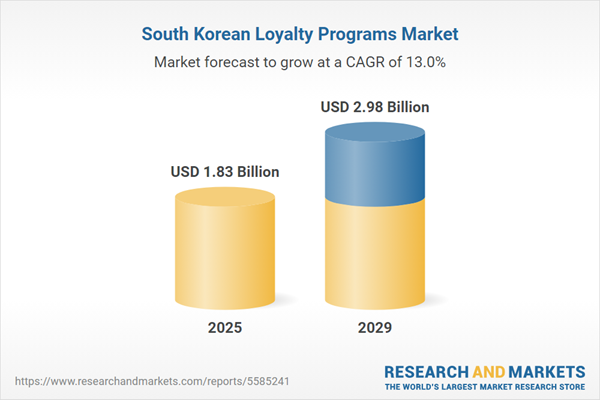
Retail and fintech giants lead the loyalty space, leveraging their ecosystem advantages to offer integrated and seamless rewards.
Dublin, Feb. 10, 2025 (GLOBE NEWSWIRE) — The “South Korea Loyalty Programs Market Intelligence and Future Growth Dynamics – 50+ KPIs on Loyalty Programs Trends by End-Use Sectors, Operational KPIs, Retail Product Dynamics, and Consumer Demographics – Q1 2025 Update” report has been added to ResearchAndMarkets.com’s offering.
The loyalty market in South Korea is expected to grow by 15.5% on annual basis to reach US$1.83 billion in 2025.
In value terms, the loyalty market in South Korea has recorded a CAGR of 17.4% during 2020-2024. South Korea’s loyalty market will continue to grow over the forecast period and is expected to record a CAGR of 13% during 2025-2029. The loyalty market in South Korea is expected to increase from US$1.58 billion in 2024 to reach US$2.98 billion by 2029.
This report provides a detailed data-centric analysis of the loyalty market opportunities and risks across a range of end-use sectors and market segments in South Korea. With over 50 KPIs at the country level, this report provides a comprehensive understanding of loyalty market dynamics, market size and forecast, and market share statistics.

Key Insights
South Korea’s loyalty program landscape rapidly advances through digital integration, government-backed incentives, and hyper-personalization. Companies like Spoqa leverage digital technologies to enhance customer engagement, catering to a highly tech-savvy consumer base that values seamless and efficient reward experiences. Simultaneously, government-supported cashback reward programs are crucial in stimulating consumer spending and supporting economic recovery, reinforcing a broader trend toward immediate financial incentives. These developments indicate a growing emphasis on convenience, personalization, and financial rewards, shaping the future of loyalty programs in the country.
The success of brand-specific and transportation loyalty programs further highlights South Korea’s strong consumer engagement with loyalty initiatives. Programs such as Starbucks Korea’s rewards system, boasting over 10 million members, demonstrate the effectiveness of exclusive perks in driving customer participation. Transportation loyalty programs such as the KTX Family Card also incentivize repeat usage, aligning with national efforts to promote public transit. As businesses refine their strategies through micro-segmentation and data analytics, loyalty programs in South Korea are expected to become even more personalized and deeply embedded in consumer lifestyles, fostering long-term brand loyalty.
Integration of Digital Technologies in Loyalty Programs
- South Korean companies increasingly incorporate advanced digital technologies into their loyalty programs to enhance customer engagement. For instance, Spoqa’s Dodo Point platform utilizes digital tools to streamline the rewards process, allowing consumers to earn points seamlessly across various retail stores.
- The widespread adoption of smartphones and a tech-savvy population drive the demand for digital solutions that offer convenience and immediacy in loyalty programs.
- This trend is expected to intensify, with more businesses leveraging digital platforms to offer personalized and efficient loyalty experiences, increasing customer retention.
Government-Supported Cashback Reward Programs
- The South Korean government has implemented cashback reward programs to stimulate consumer spending and support local businesses. These initiatives provide consumers with immediate financial incentives, encouraging increased expenditure.
- Economic policies aimed at boosting domestic consumption and aiding economic recovery post-pandemic are primary drivers of this trend.
- Such programs will likely continue, fostering a culture of immediate rewards and influencing businesses to adopt similar cashback models in their loyalty strategies.
Personalization Through Micro-Segmented Loyalty Programs
- South Korean companies are developing loyalty programs that cater to specific consumer microsegments, offering tailored benefits to enhance customer engagement. For example, Lotte Duty-Free’s “Young Travel Club” targets young travelers with customized rewards and services.
- This trend is driven by the recognition of diverse consumer preferences and the need to provide personalized experiences to different customer segments.
- Businesses are expected to increasingly adopt micro-segmentation in their loyalty programs, utilizing data analytics to offer more personalized and relevant rewards, thereby strengthening customer loyalty.
High Engagement in Brand-Specific Loyalty Programs
- Brand-specific loyalty programs have gained substantial traction in South Korea. Starbucks Korea’s rewards program has surpassed 10 million members, indicating that one in every five South Koreans is a registered member.
- Strong brand affinity and the appeal of exclusive rewards and experiences offered by such programs encourage consumers to enroll and actively participate.
- The success of brand-specific loyalty programs is likely to inspire other companies to develop or enhance their programs, focusing on unique value propositions to attract and retain customers.
Adoption of Transportation Loyalty Programs
- South Korea’s transportation sectors are implementing loyalty programs to encourage repeat usage. The KTX Family Card by Korail offers benefits such as mileage accumulation and discounts on rail tickets.
- Efforts to promote public transportation usage and reward frequent travelers contribute to the development of such programs.
- As public transportation remains a vital part of daily life, these loyalty programs are expected to evolve, offering more comprehensive benefits to enhance user satisfaction and loyalty.
Competitive Landscape: South Korea’s Loyalty Program Market
Large conglomerates, financial institutions, and technology-driven platforms drive south Korea’s highly advanced and competitive loyalty program market. Established players such as OK Cashback (Lotte), Happy Point (SPC Group), and Naver Plus Membership dominate the landscape, leveraging extensive partner ecosystems and digital innovations to enhance customer engagement. With South Korean consumers being tech-savvy and reward-conscious, companies are integrating AI-driven personalization, super apps, and blockchain-based security to differentiate their offerings.
Digital transformation, regulatory changes, and evolving consumer expectations will shape the future of South Korea’s loyalty market. Programs that offer hyper-personalized rewards, subscription-based benefits, and sustainability incentives will gain a competitive edge. While major players leverage their strong brand equity and large customer bases, new entrants must focus on niche value propositions, fintech integrations, and strategic partnerships to establish a foothold in this dynamic market.
Current State of South Korea’s Loyalty Program Market
- South Korea’s loyalty market is led by major retail and financial conglomerates, with OK Cashback (Lotte), Happy Point (SPC Group), and Shinhan Fan (Shinhan Bank) being key players.
- Retail-driven loyalty programs dominate the landscape, with Lotte’s OK Cashback and CJ Group’s CJ ONE offering extensive partner networks covering shopping, dining, and entertainment.
- Super apps and fintech disruptors are reshaping loyalty programs, with platforms like Naver Plus Membership and Kakao Pay Rewards integrating Cashback, e-commerce benefits, and digital content subscriptions.
- Subscription-based loyalty models are growing; Coupang WOW, Naver Plus, and TMON Club offer premium-tier benefits for a fixed monthly fee.
- Banking and credit card loyalty programs are highly competitive, with institutions such as Shinhan Bank, KB Kookmin Bank, and Woori Bank offering reward points, Cashback, and travel perks linked to spending.
Competition Intensity in South Korea’s Loyalty Market
- Retail conglomerates dominate, making market entry challenging for standalone programs. Lotte, CJ Group, and Shinsegae leverage their retail dominance to retain customers through integrated loyalty ecosystems.
- AI-driven personalization is a key differentiator, with Naver and Kakao using big data analytics to recommend tailored rewards and promotions based on user behavior.
- Consumers prioritize convenience and seamless redemption, pushing loyalty programs to offer real-time rewards, flexible Cashback, and cross-platform integrations. OK Cashback allows users to convert points into airline miles, gift cards, and cryptocurrency, enhancing its appeal.
- Gamification is widely used to boost engagement, with programs such as Happy Point and CJ ONE incorporating interactive challenges, referral bonuses, and digital stamp collections.
Types of Players
- OK Cashback (Lotte), CJ ONE (CJ Group), and Happy Point (SPC Group) dominate, covering shopping, dining, and entertainment rewards.
- To retain subscribers, Coupang WOW, Naver Plus, and TMON Club offer free shipping, exclusive deals, and streaming content.
- Shinhan Fan, KB Kookmin Bank, and Woori Bank offer credit card-based rewards and high-value redemption options.
- Kakao Pay Rewards and Naver Plus integrate loyalty benefits with payments, social media, and digital content, creating a one-stop digital experience.
- Korean Air’s SKYPASS and Asiana Airlines’ Asiana Club cater to frequent travelers, offering premium benefits and extensive partner networks.
Market Structure
- Retail and fintech giants lead the loyalty space, leveraging their ecosystem advantages to offer integrated and seamless rewards.
- Coalition loyalty programs (such as OK Cashback and Happy Point) are widely used, allowing consumers to accumulate and redeem points across multiple brands and industries.
- New entrants face high barriers to scaling, as existing programs offer deeply integrated omnichannel experiences and cross-brand partnerships.
- Digital-native loyalty platforms are rising, with fintech-driven solutions offering cryptocurrency-based rewards, real-time Cashback, and AI-powered recommendations.
- Evolving consumer data protection regulations are increasing operational complexities, pushing companies to prioritize transparent and secure data management practices.
Future Competitive Landscape
- AI-driven hyper-personalization will become a key differentiator, with loyalty programs leveraging machine learning to provide real-time, behavior-based incentives. Naver and Kakao are expected to expand their AI-driven loyalty offerings.
- Coalition loyalty networks will continue to grow, with businesses seeking cross-industry partnerships to enhance point accumulation and redemption options.
- Sustainability-focused rewards will gain momentum, as South Korean consumers become increasingly eco-conscious. Programs that offer incentives for green purchasing, carbon offsetting, and ethical consumption will attract more engagement.
- Regulatory oversight will intensify, requiring brands to adopt privacy-first loyalty models and enhance consumer protection mechanisms.
Key Attributes:
| Report Attribute | Details |
| No. of Pages | 130 |
| Forecast Period | 2025 – 2029 |
| Estimated Market Value (USD) in 2025 | $1.83 Billion |
| Forecasted Market Value (USD) by 2029 | $2.98 Billion |
| Compound Annual Growth Rate | 13.0% |
| Regions Covered | South Korea |
Report Scope
This report provides in-depth, data-centric analysis of loyalty programs in South Korea. Below is a summary of key market segments.
- South Korea Retail Sector Spend Value Trend Analysis
- South Korea Loyalty Spend Market Size and Future Growth Dynamics by Key Performance Indicators
- Value Accumulated and Value Redemption Rate of Loyalty programs in South Korea
- South Korea Loyalty Spend Market Size and Future Growth Dynamics by Functional Domains
- South Korea Loyalty Spend Market Size and Future Growth Dynamics by Loyalty Program Type
- South Korea Loyalty Spend Market Size and Future Growth Dynamics by Channel
- South Korea Loyalty Schemes Spend Market Size and Future Growth Dynamics by Business Model
- South Korea Loyalty Spend Market Size and Future Growth Dynamics by Key Sectors
- South Korea Loyalty Spend Market Size and Future Growth Dynamics in Key Sectors by Online
- South Korea Loyalty Spend Market Size and Future Growth Dynamics in Key Sectors by In-Store
- South Korea Loyalty Spend Market Size and Future Growth Dynamics in Key Sectors by Mobile App
- South Korea Loyalty Spend Market Size and Future Growth Dynamics by Retail
- South Korea Loyalty Spend Market Size and Future Growth Dynamics by Accessibility
- South Korea Loyalty Spend Market Size and Future Growth Dynamics by Consumer Type
- South Korea Loyalty Schemes Spend Market Size and Future Growth Dynamics by Membership Type
- South Korea Loyalty Platform Spend Market Size and Future Growth Dynamics by Software Use Case
- South Korea Loyalty Platform Spend Market Size and Future Growth Dynamics by Vendor/Solution Partner
- South Korea Loyalty Platform Spend Market Size and Future Growth Dynamics by Deployment
- South Korea Loyalty Spend Market Size and Future Growth Dynamics by Loyalty Platforms
- South Korea Loyalty Spend Market Size and Future Growth Dynamics by Software Use Case Platforms
- South Korea Loyalty Spend Market Size and Forecast by Consumer Demographics & Behaviour
For more information about this report visit https://www.researchandmarkets.com/r/9yfk6g
About ResearchAndMarkets.com
ResearchAndMarkets.com is the world’s leading source for international market research reports and market data. We provide you with the latest data on international and regional markets, key industries, the top companies, new products and the latest trends.
Attachment
CONTACT: CONTACT: ResearchAndMarkets.com
Laura Wood,Senior Press Manager
press@researchandmarkets.com
For E.S.T Office Hours Call 1-917-300-0470
For U.S./ CAN Toll Free Call 1-800-526-8630
For GMT Office Hours Call +353-1-416-8900

